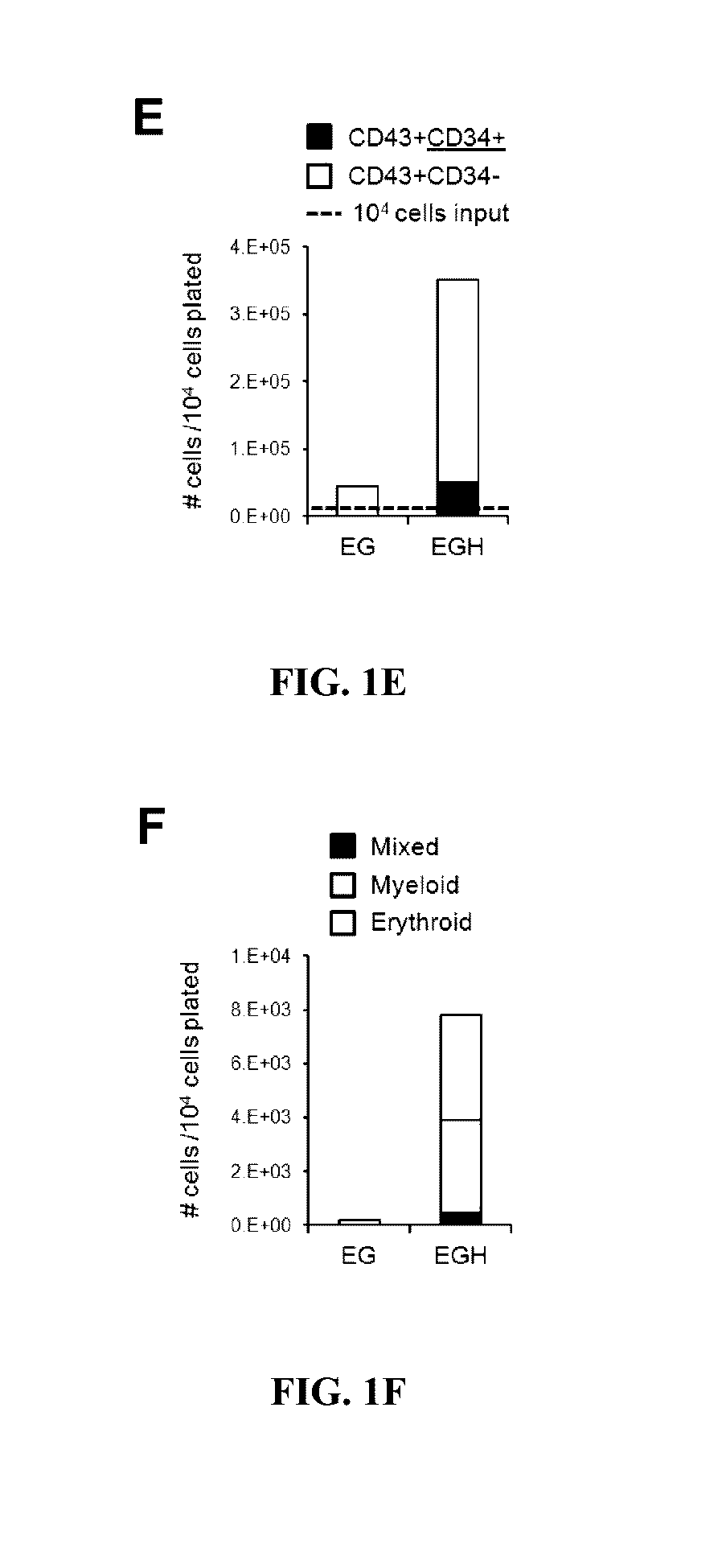Multi-lineage hematopoietic precursor cell production by genetic programming
a technology of hematopoietic precursor cells and genetic programming, which is applied in the field of multi-lineage hematopoietic precursor cells produced by genetic programming, can solve the problems of limited approach, low transdifferentiation efficiency, and major restriction on their wide use in clinics
- Summary
- Abstract
- Description
- Claims
- Application Information
AI Technical Summary
Benefits of technology
Problems solved by technology
Method used
Image
Examples
example 1
Linked Expression of ETV2 / ERG, GATA2 and HOXA9 Efficiently Programs Human PSCs to Immature CD34+ Hematopoietic Progenitors
[0204]The present studies were conducted to produce hematopoietic precursors with multi-lineage potential including myeloid and lymphoid potential. Multiple configurations of programming genes were tested for programming efficiency to achieve multi-lineage potential (Table 2). Coding regions of the transgenes were cloned into PiggyBac expression vectors under the control of the rtTET-inducible Tight promoter (pTight). ETV2 / ERG and GATA2 (E+G) were cloned in separate expression vectors bearing blasticidin and geneticin resistance, respectively. Combined blasticidin and geneticin selection was used to achieve ETV2 / ERG and GATA2 co-expression in transfected cells. Alternatively, for balanced uniform expression in transfected cells, ETV2 / ERG and GATA2 (EG) were linked through the F2A-cleaveage peptide in one pTight-controlled expression cassette. It was found that th...
example 2
Enhancement of the Multi-Lineage Potential of Immature Hematopoietic Precursors
[0208]Additional genes were screened to improve the forward programming efficiency of PSCs to the immature hematopoietic progenitors. A screening model was devised to detect additional genes that could be complementary to ETV2 / ERG-GATA2-HOXA9 (EGH) for improved production of immature, CD43+CD34− and CD43−CD34−CD133+ cells.
[0209]Since pCMV has been shown to be essentially suppressed in undifferentiated human PSCs and to have active expression in differentiated cells such as HPCs, studies were conducted to find out whether this feature of the CMV promoter could be used for post-induction gene expression in the induced CD43+ cells. pCMV-EGFP and pTight-EG constructs were introduced in rtTET-expressing human PSCs using PiggyBac expression vectors. EGFP expression in CD43+ cells was monitored following DOX-induced hematopoietic programming. In the undifferentiated / non-induced iPSCs, and up to day 8 of DOX-indu...
example 3
Hematopoietic Stem Cell Programming Genes Confer Long-Term Engraftment Potential
[0212]A screening model was devised to detect hematopoietic stem cell programming genes that can be combined with the EGH expression vector to enable long-term hematopoietic engraftment. CD34+ cells transfected with EGH and different test gene combinations (e.g., up to 20 genes per combination) were purified from day 8 DOX induction cultures by magnet-activated cell sorting (MACS) (FIG. 5A). For immediate post-induction injection, 4×106 CD34+ cells were plated in recovery culture at 106 cells / ml in HSC medium (e.g., StemSpan SFEM supplemented with SCF, FLT3L and TPO (100 ng / ml each)), harvested after 18-24 hours and injected intravenously in 6-8 week old NOD / SCID / IL2Rg− / c-kitW41 (NBSGW) mice. Injected mice were then placed in cages with DOX-containing diet (i.e., 625 mg DOX / kg) to provide DOX supply for continuous transgene expression in vivo for 7 days. For injection of the HSC culture adapted cells, 0....
PUM
| Property | Measurement | Unit |
|---|---|---|
| time | aaaaa | aaaaa |
| size | aaaaa | aaaaa |
| length | aaaaa | aaaaa |
Abstract
Description
Claims
Application Information
 Login to View More
Login to View More - R&D
- Intellectual Property
- Life Sciences
- Materials
- Tech Scout
- Unparalleled Data Quality
- Higher Quality Content
- 60% Fewer Hallucinations
Browse by: Latest US Patents, China's latest patents, Technical Efficacy Thesaurus, Application Domain, Technology Topic, Popular Technical Reports.
© 2025 PatSnap. All rights reserved.Legal|Privacy policy|Modern Slavery Act Transparency Statement|Sitemap|About US| Contact US: help@patsnap.com



